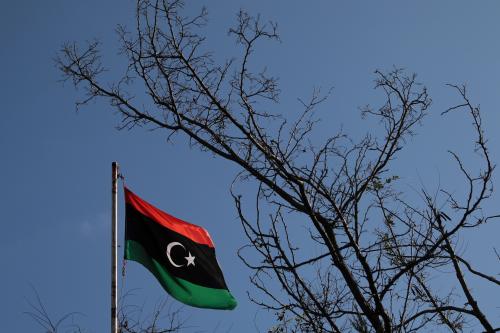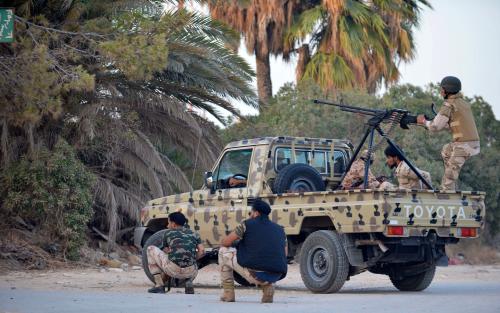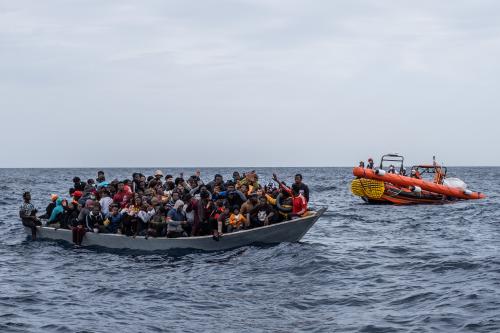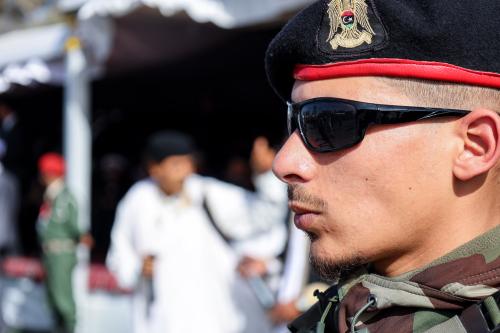This piece is part of a series titled “Nonstate armed actors and illicit economies: What the Biden administration needs to know,” from Brookings’s Initiative on Nonstate Armed Actors.
Libyans can mark the 10th anniversary of the uprising against Moammar Gadhafi (generally accepted to have begun on February 17, 2011) with something in short supply since Libya’s 2014 descent into division and civil war: hope.
On February 5, the United Nations Support Mission in Libya (UNSMIL)-facilitated Libyan Political Dialogue Forum (LPDF) selected a new interim Libyan executive authority. This has created significant momentum. At the same time, the situation is fragile, and the next few weeks are critical.
How we got here
Military realities created a political opening
A year ago, with Tripoli under siege by General Khalifa Haftar, Libya appeared irreparably broken. National institutions had by that point been long divided between factions in Libya’s east and west, and bereft of domestic legitimacy. With oil exports halted, economic and social conditions rapidly deteriorated. COVID-19 and conflict conspired to greatly increase the population’s misery.
Yet Haftar’s assault, which began in 2019 — with significant support from the United Arab Emirates, Russia, and Egypt — eventually created the conditions that then-U.N. Special Representative Ghassan Salamé used to establish the political processes that now promise to put Libya back together again. With the United Nations Security Council paralyzed by divisions over Libya, Salamé designed an international conference hosted by Germany in January 2020 to build global consensus that would provide an international umbrella for the three intra-Libyan tracks, led by Libyans themselves.
On the ground in Libya, Haftar’s use of sophisticated weaponry and intelligence from his outside backers — not to mention the dispatch of mercenary forces — prompted the desperate Tripoli government to reach out to Turkey for help. In a humiliating reversal for Haftar, Turkish military support helped end the siege of Tripoli and chase his forces eastward. The de facto truce established in central Libya in June 2020, centered in the vicinity of Sirte, was a tacit acknowledgement by the outsiders that neither the Tripoli government, with its Turkish backers, nor Haftar’s forces, with his UAE and Russian supporters, could prevail militarily over the whole country.
Enter a so-called “5+5” framework. Ten officers (eight of them generals) — five representing the Government of National Accord, and five appointed by Haftar — were not strangers to each other: all served under long-time Libyan dictator Moammar Gadhafi. The calm on the ground in the summer and early fall of 2020 allowed the 5+5 to propose meeting face-to-face, with facilitation by UNSMIL. While they represented opposing sides that had received outside military support, the 10 officers quickly reached consensus that all of the foreigners needed to leave, to help de-escalate the situation. Given the large number of mercenaries and the increasing occupation of Libyan military bases, Libyans were fast losing the ability to decide their country’s future for themselves. The occupation of their bases had become an affront to Libyans who have long expressed suspicions about foreign designs on their country. This shared interest that Libyans not cede control of their country to outsiders led to the 5+5 announcement on October 23 that the de facto truce around Sirte was now a national ceasefire, with a 90-day deadline for all foreign troops to leave. (While some external observers continue to muse about a U.N. or other peacekeeping force, the 5+5 rejected “Blue Helmets” out of hand. Instead, they proposed a small, scalable civilian unarmed observer force under UNSMIL with a limited mandate to monitor the ceasefire and the withdrawal of foreign troops and mercenaries. They also insist upon the right to veto monitors with nationalities from countries that intervened in Libya militarily or deployed mercenaries.)
The Libyan public celebrated the October 23 ceasefire agreement, and the 5+5 soon became minor celebrities with their patriotic declarations and calls for national reconciliation. The 5+5 process created pressure on the politicians. If the generals could produce results that transcended Libya’s multiple divides, why not the political leaders? The fractured institutions the politicians led were successful only in enriching their own networks, as the Libyan people descended more deeply into misery of economic deprivations and failing services, as COVID-19 raged. And in addition to the ceasefire, the 5+5 talks enabled a de-mining process essential to re-opening the important coastal road between Abu Grein and Sirte, facilitated several detainee exchanges, and enabled the opening of domestic air routes throughout the country.
Transparency gave a political roadmap legitimacy
Following a series of Track II meetings facilitated by the Geneva-based Centre for Humanitarian Dialogue, the seeds were laid for convening the first LPDF meeting in Tunis in November and drafting the LPDF Roadmap. The roadmap acknowledges what nationwide polling consistently highlights: that Libyans demand the unification of the country’s institutions and national elections. The roadmap is grounded in the need to protect and promote human rights and to advance the principles of transitional justice, including accountability.
The LPDF itself comprises elected representatives from the two “Skhirat” institutions (referring to the hijacked 2015 Libyan Political Agreement negotiated and signed in Skhirat, Morocco), the House of Representatives (HoR) in the east, and the High Council of State. These elected representatives are rounded out by the so-called UNSMIL bloc, including a cross-section of political forces, youth, women, ethnic groups and tribes, and geographically diverse personalities. Notably, the LPDF included supporters of the former regime, the first major political event since the 2011 revolution to include the so-called “Greens.”
Not surprisingly, great controversy surrounded the selection of the LPDF members. In order to boost the forum’s legitimacy, UNSMIL created sub-tracks for women, youth, and municipalities, and launched a series of digital dialogues working with the U.N.’s Department of Political and Peacebuilding Affairs Innovation Unit at U.N. headquarters. Five digital dialogues were held between October and February, with over 1,000 mostly young Libyans participating in each session.
This commitment to transparency deepened earlier this month, when the 45 candidates vying for positions in the interim executive authority appeared live via television and Facebook before the Libyan public. This was an unprecedented way to present their candidacies, forcing them to respond to tough questions submitted by the public. Any whiff of smoke-filled backroom dealings dissipated, with at least 1.7 million Libyans — between a quarter and a third of the population — tuning in. Unaccustomed to such public grilling of their political class, Libyans embraced what became known as the “National Barbeque Session.” In addition, UNSMIL required candidates to orally commit to and sign pledges to uphold the roadmap, commit to hold national elections on December 24, 2021, accept the outcome of the LPDF selection process, and in the case of the prime ministerial candidates, agree to appoint women to 30% of senior executive positions.
Unaccustomed to such public grilling of their political class, Libyans embraced what became known as the “National Barbeque Session.”
In parallel to these political developments, there has also been notable progress in the UNSMIL-facilitated economic track: For the first time since 2014, Libya has a unified budget. The Central Bank Board met in December, after a five-year lapse, to unify the country’s exchange rate, mitigating the liquidity crisis. And it has finally agreed to extend loans to banks that have been under the strain of a growing backlog of uncleared checks resulting from the divided banking settlement system between east and west.
Amid new momentum, five key tasks
All the key domestic actors — including the usually contrary General Haftar — have endorsed the LPDF process. Key external actors — including the leaders of Egypt, Turkey, the United Arab Emirates, France, and Russia — have likewise lauded the developments. The United States joined with France, Germany, Italy, and the United Kingdom in a joint endorsement of the LPDF process. Describing the LPDF results as “an important milestone,” the U.N. Security Council overcame divisions to issue a presidential statement welcoming the announcement of interim authorities.
For this momentum to be sustained, Libyan stakeholders and the international community must act quickly. As they continue the creative facilitation that helped the Libyans start to transcend their divisions, UNSMIL and the new special envoy to Libya, Jan Kubis, need to be able to count on the external actors who spent the past several years exacerbating Libya’s divisions to pivot in support of the process — in deeds as well as words.
First, Prime Minister-designate Abdulhameed Dbeiba should form a small, inclusive, technocratic government with a discrete set of tasks: deliver services to municipalities long starved of resources, provide support nationwide to combat the pandemic, invest in the electricity infrastructure to avert the predicted collapse of the grid in summer 2021, unite executive and sovereign institutions, and pave the way for the elections in December. Per the LPDF roadmap, Dbeiba has 21 days from his February 5 selection to propose his cabinet.
Second, the notoriously fractious HoR, Libya’s parliament based in Tobruk, must endorse the new executive within 21 days of Dbeiba’s submission of his cabinet choices and government program. Ominously, rival HoR factions have unhelpfully issued competing calls for sessions, and the United Nations and the international community can help mediate to organize a single meeting. The parliament members should be persuaded to emulate the example set by the LPDF and 5+5 processes and put aside their differences for the sake of the country.
Third, the LPDF should seize the reins they assigned themselves as the guardians and monitors of the process and the executive that they created. The roadmap, to which the LPDF members consensually agreed in a November meeting in Tunis, is the critical marjaiya — or reference point — moving forward. LPDF members designed the roadmap to prevent a repetition of what happened to the 2015 Libyan Political Agreement, when status quo institutions (including the HoR) simply dismissed obligations to re-unify executive authorities. Anticipating that parallel institutions — namely the current internationally recognized government in Tripoli and the parallel executive in Beyda — could fail to disband in favor of a new unified executive, the LPDF baked fallback mechanisms into the roadmap: If institutions fail to honor the decision points and deadlines, the matter returns to the LPDF.
Fourth, both the new government and the international community must support robustly the High National Elections Commission. While technically capable, and a recipient of U.N. technical assistance since 2012, the commission will require additional help to conduct presidential and parliamentary elections in December.
Fifth, the countries that are directly interfering in Libya’s internal affairs need to honor their commitments to abide by the January 2020 Berlin conference conclusions, United Nations Security Council Resolution 2510 (2020), and the U.N. arms embargo in place since 2011 and renewed annually. While the January 23 deadline set in November by the 5+5 security talks expired without compliance, those who dispatched forces and mercenaries to Libya need to respect a demand the Libyans consider binding and relevant to the success of the current process.
What lies ahead
It is important to remember that the interim government won’t (and shouldn’t) do everything. Those selected for interim roles, notably the prime minister-designate, have courted controversy in the past. But the polling indicates that the public seems to have embraced this new united executive as a bridge toward the much-demanded elections. Given what is supposed to be its limited shelf life, the new government can sustain the legitimacy needed to oversee elections by keeping its work program modest and targeted immediately on improving living conditions and delivering services. The interim Presidency Council, selected on February 5, should seriously embrace the task accorded to it in the roadmap to launch a National Reconciliation program. There are some tasks — such as decentralization — that will require more time, and an elected government with popular legitimacy conferred by credible elections. As Desmond Tutu said, the only way to eat an elephant is a bite at a time.
Without question, the road ahead is challenging. A glance at Libya’s prolonged agony since the unified institutions teetered and then collapsed in 2014 will cure even the most optimistic observer of believing in quick fixes. The aborted 2015 Libyan Political Agreement, applauded by many when signed, is a sobering precedent. Unsurprisingly, the current political process has thus drawn its share of negative, skeptical, and even hysterical analysis from both inside and outside Libya.
It is relatively easy to point to risks, weaknesses, and imperfections in the LPDF process. What is harder is finding an alternative path that does not squander the most promising moment Libya has had in years, with the combination of a ceasefire, various processes transcending Libya’s divides, economic breakthroughs, and a population yearning to move toward elections. The roadmap’s ambitious timelines will soon reveal whether the publicly televised oral commitments by current political leaders to step aside in favor of the new interim authorities were offered in good faith.
Going forward, the international community will need to curb the appetite of the Dbeiba government, work to limit armed group interference in the government’s work, and push all institutions to produce the national elections. The LPDF will need to shoulder its responsibilities as the guardians of the process. The new U.S. administration, with a small investment and use of Washington’s convening authority, can help the U.N., as can the countries and organizations that participate in the Berlin process. With these concerted efforts, Libyans can perhaps usher in the second post-revolutionary decade with a measure of hope for increased stability and security and the holding of national elections to renew the democratic legitimacy of Libya’s institutions.
The Brookings Institution is committed to quality, independence, and impact.
We are supported by a diverse array of funders. In line with our values and policies, each Brookings publication represents the sole views of its author(s).








Commentary
Can a political breakthrough mend a broken Libya?
February 17, 2021